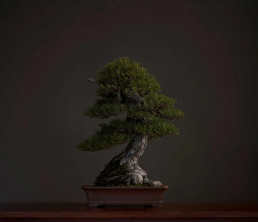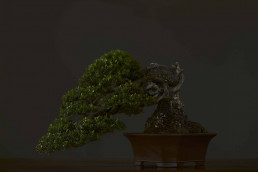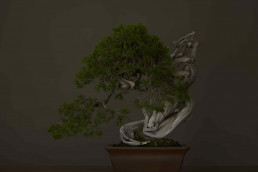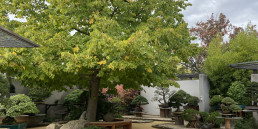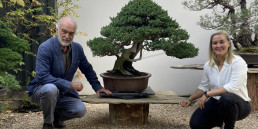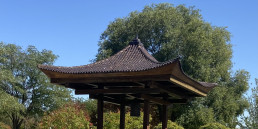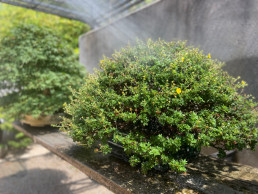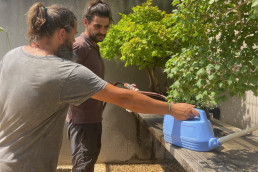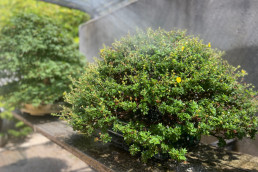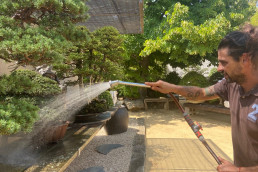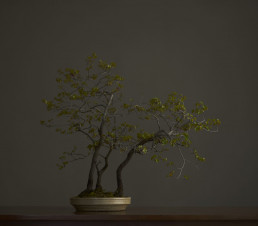Pino negro del Pirineo/Pyrenean mountain pine
En una semana complicada en gran parte de España, un pequeño homenaje a nuestros paisajes y a nuestros árboles; olivos, encinas, alcornoques, sabinas, hayas, robles, pinos…
Pino negro del Pirineo.
En los altos pirenaicos de Belagua van
cojeando los rebaños de ovejas lachas entre
pinos negros, sobre un terreno kárstico
repleto de agujeros.
“a los pinos el viento”. Luis Vallejo
fotografía Fernando Maquieira.
In what has been a difficult week in much of Spain, here is a small tribute to our landscapes and our trees: olive trees, holm oaks, cork oaks, junipers, beeches, oaks, pines…
Pyrenean mountain pine.
In the pyrenean heights of Belagua the flocks
of Latxa sheep hobble along among black pines
over a Karstic terrain full of holes.
“The Wind among the Leaves”. Luis Vallejo
Photograph Fernando Maquieira.
Riego/Watering
Llevamos una semana de mucho calor,, el riego lo ocupa todo.; nuestro tiempo y nuestra energía. Para saber regar hace falta experiencia,…en Japón para regar necesitas una formación de unos tres años.
Cuando te pones frente a un bonsái y tomas la decisión de regarlo o no, tienes en cuenta algunos factores; último riego, ubicación, época del año, especie, si el sustrato drena bien, profundidad de la maceta, estado general, experiencia en los días anteriores… todo esto a 40 grados y con un número considerable de arboles por regar. Si le añadimos que las nuevas generaciones riegan escuchando reguetón o el ultimo podcast sobre fenómenos UFO…igual habría que ampliar la formación unos cuantos años más…
Pero con la experiencia, la cosa no es para tanto, la decisión se toma muy rápido y el resto del tiempo aprovechas para ver los árboles, el jardín…observar las plantas que nacen en las traviesas o en las piedras. En estos días invertir tanto tiempo en algo, concentrare en una sola cosa y darle el tiempo que necesita puede ser terapéutico y cuando la temperatura no es tan alta hasta lo disfrutas.
Watering takes up all our time and energy. To know how to water properly, you need experience. It takes about three years of training to learn how to water in Japan.
When you stand in front of a bonsai and decide to water it or not, you take a number of factors into account: when it was last watered, its location, the time of year, the species, if the substrate drains well, the depth of the pot, its general condition, your experience in previous days… all this at 40 degrees and with a considerable number of trees to water. If we add to that the fact that the younger generations water while listening to reggaeton or the latest podcast on UFO phenomena… maybe we should extend the training by a few more years…
But with experience, it’s not such a big deal, the decision is made very quickly and the rest of the time you can enjoy looking at the trees, the garden… observing the plants that grow on the sleepers or stones. These days, investing so much time in something, concentrating on one thing and giving it the time it needs can be therapeutic, and when the temperature isn’t so high, you can even enjoy it.
Otras publicaciones
Nombres/Names
Los nombres son importantes, de pequeños lo primero que aprendemos a nombrar es lo que mas nos importa. En el jardín tenemos nombres para todos los árboles. Según su procedencia: ” el junípero de kimura” (hay varios juníperos de Kimura, pero solo a uno lo llamamos así) “la zelcova de Gabriel García Márquez” (y su historia…) “el kaede de Kato”….y según la especie cuando solo hay uno: “el procumbens”, “el arakawa”,” el shirasawanum”…
Tenemos otro tipo de nombres, los míticos, heredados de un pasado que alguno ni hemos vivido: “el hermano pequeño” y “el hermano mayor” dos pinos albares de los primeros diseños de Luis que estaban plantados en kurama y se hicieron famosos, “el luchador de sumo”; un acebuche al que puso nombre Kobayashi mientras imitaba la postura de un luchador, “la Medusa” de Luis, un haya de melena imponente, o” la bailarina” un pino blanco bunjin que parece que está bailando.
Por último, están los nombres de estar por casa; estos surgen de un momento de necesidad o de inspiración (según se mire) de uno de nosotros. En esta categoría tenemos al pulpo, el flying rock, el no manzano, el antenas, el saca ojos, el ex feo, …y una larga lista de la que no estamos orgullosos.
Al de la foto, un grupo de cercis silicuastrum, Luis le puso hace unos días “el castigado”. Estos días está al fondo del vivero, resguardado del sol… cree que deberíamos darle una ubicación más digna.
.
Names are important. As children, the first thing we learn to name is what matters most to us. In the garden, we have names for all the trees. Depending on their origin: ‘Kimura’s juniper’ (there are several Kimura junipers, but we only call one of them that), ‘Gabriel García Márquez’s zelkova’ (and its story…), ‘Kato’s kaede’… and depending on the species when there is only one: ‘the procumbens’, ‘the arakawa’, ‘the shirasawanum’…
We have other types of names, the mythical ones, inherited from a past that some of us have not experienced: ‘the little brother’ and ‘the big brother’, two Scots pines from Luis’s early designs that were planted in Kurama and became famous, ‘the sumo fighter’; a wild olive tree that Kobayashi named while imitating the posture of a fighter, Luis’s ‘Medusa’, a beech tree with an imposing mane, or ‘the ballerina’, a bunjin white pine that looks like it is dancing.
Finally, there are the everyday names; these arise from a moment of necessity or inspiration (depending on how you look at it) from one of us. In this category we have the octopus, the flying rock, the non-apple tree, the antennae, the eye-gouger, the ex-ugly… and a long list that we are not proud of.
The one in the photo, a group of cercis silicuastrum, was named ‘the punished one’ by Luis a few days ago. These days it is at the back of the nursery, sheltered from the sun… he thinks we should give it a more dignified location.
Otras publicaciones
Equipo/Team
Esta es la foto del equipo en el otoño de 2021, no hemos vuelto a hacernos otra …aquí faltan personas fundamentales; Mario estaba entonces y siempre (pero no en la foto), Alejandro aún no había llegado…no es la época de nuestros primeros aprendices Rober y Álvaro…ahora Sara no está.
No es siempre el mismo equipo, pero la foto sirve para hacer un homenaje a las personas que están detrás de todas las historias que contamos aquí. Los que cuidan de los árboles y mantienen este jardín para que la gente pueda seguir disfrutándolo.
This is a photo of the team in the autumn of 2021. We haven’t taken another one since then… Some key people are missing here: Mario was there then and always has been (but not in the photo), Alejandro hadn’t arrived yet… It’s not the era of our first apprentices, Rober and Álvaro… Now Sara is gone.
It’s not always the same team, but the photo serves as a tribute to the people behind all the stories we tell here. Those who care for the trees and maintain this garden so that people can continue to enjoy it.
Otras publicaciones
Los árboles/The trees
Los árboles
El bonsái es una forma de mirar. Cuando miras un bonsái, vuelves a un lugar en el que una vez viste un árbol; la higuera que crecía en el patio de una casa, un pino descolgándose de un acantilado recuerdo de un viaje por carretera, las encinas de una dehesa por la que solías pasear o la primera vez que entraste en un hayedo…
Cada árbol nos lleva al lugar del que viene, nos lleva de vuelta a la naturaleza, al momento que vivimos en ella. Cuando nos visitan personas mayores nos damos cuenta de lo importante que han sido los árboles en sus vidas. Todos tienen algún recuerdo relacionado con ellos, se emocionan recordando.
La parte que corresponde a este arte es captar la esencia del árbol, provocar esa emoción, ese recuerdo. La otra parte, nos corresponde a todos; hacer posible que las generaciones futuras sigan teniendo recuerdos ligados a los árboles, a la naturaleza.
El haya, el árbol madre, mi árbol más querido. Sus hojas al caer y acumularse, producen el suelo más fértil.
Luis Vallejo. «a los pinos el viento»
The trees
Bonsai is a way of looking. When you look at a bonsai, you go back to a place where you once saw a tree; the fig tree that grew in the courtyard of a house, a pine tree overhanging a cliff that reminds you of a road trip, the holm oaks in a dehesa where you used to walk, or the first time you entered a beech forest…
Each tree takes us back to the place it came from, it takes us back to nature, to the moment we lived in it. When older people visit us we realise how important trees have been in their lives. They all have some memory related to them, they are moved by remembering.
The part that corresponds to this art is to capture the essence of the tree, to provoke emotion. The other part is up to all of us; to make it possible for future generations to continue to have memories linked to trees, to nature.
The beech, the mother-tree, the tree dearest to me. Its fallen, piled-up leaves produce the most fertile soil.
Luis Vallejo. «The Wind Among the Leaves»
Otras publicaciones
"Hay que tener agallas"/ "It take galls"
Como todos los años, el roble está lleno de agallas. Parecen pequeños frutos.
Cada vez que paso cerca pienso en la expresión “tener agallas”; que podría querer decir que las plantas son valientes por la capacidad que tienen para defenderse. Porque las agallas son eso, una defensa ante el ataque de algún insecto, signo del mecanismo de defensa de la planta…está bien que tengan agallas. Descubro que existe una ciencia que lo estudia; la cecidología, una colección de seis mil muestras en el Museo de Ciencias Naturales y que se puede saber que insecto la ha provocado en función de la forma que tenga.
Pero si algo llama la atención es la perfección absoluta de la Naturaleza porque la planta al defenderse del ataque forma una estructura para aislar la amenaza que a su vez sirve al intruso de cobijo y alimento hasta completar su desarrollo.
La decepción vino después cuando supe que la expresión viene del parecido de las agallas de los robles con los testículos, símbolo de valentía y coraje…así que en realidad la expresión es parecida a “tener pelotas”…todo menos poético…
Like every year, the oak tree is full of galls. They look like small fruits.
There is an expression in Spanish «it take galls», similar to «It take guts». Every time I pass by the tree I think of the expression; which could mean that plants are brave because of their ability to defend themselves. Because that’s what galls are, a defence against an insect attack, a sign of the plant’s defence mechanism… it’s good that they have galls. I discovered that there is a science that studies it; cecidology, a collection of six thousand samples in the Museum of Natural Sciences, and that you can tell which insect has caused it by the shape it has.
But if anything is striking, it is the absolute perfection of Nature, because the plant, when defending itself from the attack, forms a structure to isolate the threat, which in turn serves the intruder as shelter and food until it completes its development.
The disappointment came later when I found out that the expression comes from the resemblance of the gills of the oaks with the testicles, symbol of bravery and courage… so in reality the expression is similar to ‘having balls’… anything but poetic…
Otras publicaciones
The pink lotus
Durante el verano todo parece peor; los árboles luchando contra el calor sofocante de Madrid, nosotros con aspecto de beduinos, el jardín descolocado, la tienda desmontada y el taller con las persianas bajadas. Solo hay algo que mejora en esta temporada, lo único que está en su momento de esplendor. Los estanques.
Han estado en el jardín desde el principio, pasan altibajos; en algún momento y en función de quien los cuida, lucen espectaculares o son simples láminas de agua estancada.
Como tantas otras cosas, se trata de un mundo apasionante con mil posibilidades. Cuando te sumerges en este mundo, aprendes sobre valores de ph y nitritos, a distinguir plantas, tipos de peces, y sobre el fascinante mundo de los aspiradores de lodo…pero nada te prepara para la explosión de vida en torno al agua; de pronto aparecen flores (que parecen de otro mundo),libélulas azules, ranas que deben haber cruzado calles y rotondas atraídas por el agua, peces que se reproducen a un ritmo exagerado y una mañana sin previo aviso te encuentras tres tortugas tomando el sol y a una garza real pescando.
No podemos dejar de mencionar a Tomás Escribano apasionado experto en plantas acuáticas y estanques, que nos ha enseñado tanto y ha introducido nuevas variedades de nenúfar a nuestros estanques.
During the summer everything seems worse; the trees struggling against the sweltering heat of Madrid, us looking like Bedouins, the garden untidy, the shop dismantled and the workshop with the blinds down. There is only one thing that is improving this season, the only thing that is at its peak. The ponds.
They have been in the garden since the beginning, they go through ups and downs; at some point and depending on who takes care of them, they look spectacular or they are a simple water sheet of stagnant water.
Like so many other things, it is an exciting world with a thousand possibilities. When you immerse yourself in this world, you learn about pH and nitrite values, how to distinguish plants, types of fish, and the fascinating world of sludge vacuums… but nothing prepares you for the explosion of life around the water; suddenly there are flowers (that seem to be from another world), blue dragonflies, frogs that must have crossed streets and roundabouts attracted by the water, fish that reproduce at an exaggerated rate, and one morning without warning you find three turtles sunbathing and a grey heron fishing.
We cannot forget to mention Tomás Escribano, a passionate expert in aquatic plants and ponds, who has taught us so much and has introduced new varieties of water lily to our ponds.
Otras publicaciones
Balneario de verano/Summer spa
Con el museo cerrado durante el verano, nos centramos en conseguir que los árboles lleguen en la mejor forma posible al otoño.
Sin las visitas, ni los proyectos y actividades del resto del año, el día gira en torno al riego. El poco tiempo que sacamos al riego lo usamos para trabajos puntuales en los árboles; limpieza de pinos, trabajar tejos, piceas y olivos y el mantenimiento del jardín.
Para proteger los árboles, los colocamos en las zonas de sombra, muchos acaban en la zona central, bajo el tilo, otros en la zona del vivero que es mas fresca que la zona expositiva. Las macetas protegidas con telas blancas…
Los pocos que acceden en estos días dicen que les gusta casi más, es como ver la trastienda, algo inusual que normalmente no puedes ver. Como dijo alguno, parece que los árboles estuvieran en un balneario, recibiendo cuidados en sus albornoces blancos…
With the museum closed for the summer, we focus on getting the trees into autumn in the best possible shape.
Without the visits, or the projects and activities of the rest of the year, the day revolves around watering. The little time we have after watering is used for occasional work on the trees; cleaning the pines, working on the yews, spruces and olive trees and maintaining the garden.
To protect the trees, we place them in the shaded areas, many end up in the central area, under the lime tree, others in the nursery area which is cooler than the exhibition area. The pots are protected with white cloths…
The few who visit these days say they like it almost more, it’s like seeing the back room, something unusual that you can’t normally see. As someone said, it looks like the trees are in a spa, receiving treatment in their white bathrobes.
Otras publicaciones
La joyería/The jewellery shop
Este Museo no es un jardín…es una joyería.
Todo se ordena y concibe para exponer y magnificar la belleza de los Bonsáis.
El Jardín se diseña con estética Wabi Sabi. Imperfección, fragilidad, endeblez…Con una concepción minimalista en los elementos con los que se compone. Muro, umbráculo, estanque…Y brutalista en el carácter de los materiales usados….Hormigón, roca, albero, agua…
A la manera de Kyoto…la forma de componer es asimétrica, como es concebida en los jardines y templos de la ciudad nipona.
El jardín de bonsáis de Luis Vallejo es un “jardín joyero” y también un “jardín fenomenológico” donde los sentidos adquieren un protagonismo relevante.
Jugando con la sorpresa y el efecto, el jardín de Bonsais expresa y contrapone opuestos; Color/Fondo/Textura, Sombra/Luz, Brillo/Mate, Quietud/Movimiento. Un baile de conceptos.
Para llegar al Miabi “capacidad de apreciar la belleza”. Para percibir, en los bonsáis de esta joyería…el efecto hermoso del viento y el tiempo como creador de drama, equilibrio y belleza.
Texto y dibujo del arquitecto Iñigo Ortiz @ortiz_inigo
This museum is not a garden… it is a jewellery shop.
Everything is arranged and designed to display and magnify the beauty of the Bonsai trees.
The Garden is designed with Wabi Sabi aesthetics. Imperfection, fragility, weakness… With a minimalist conception in the elements with which it is composed. Wall, umbraculum, pond…And brutalist in the character of the materials used….Concrete, rock, soil, water…
In the Kyoto way…the way of composing is asymmetrical, as it is conceived in the gardens and temples of the Japanese city.
Luis Vallejo’s bonsai garden is a “’jewellery garden”’ and also a “’phenomenological garden”’ in which the senses take on an important role.
Playing with surprise and effect, the Bonsai garden expresses and contrasts opposites; Colour/Background/Texture, Shadow/Light, Brightness/Matte, Stillness/Movement. A dance of concepts.
To reach the Miabi ‘ability to appreciate beauty’. To perceive, in the bonsai of this jewellery… the beautiful effect of wind and time as a creator of drama, balance and beauty.
Text and drawing by the architect Iñigo Ortiz @ortiz_inigo.
Otras publicaciones
Microestaciones/ Micro-seasons
Las estaciones en Japón son muchas más que cuatro; se cuentan hasta 72 microestaciones y cada una describe cambios casi imperceptibles que se producen a nuestro alrededor.
Cada mes, cada semana del año, cada día ocurre algo único; el ruido de las grullas anunciando que llega el frío, la calma de los meses de invierno, las primeras flores de los frutales, la temporada de las glicinias, el momento en que brotan los nenúfares y aparecen las primeras ranas, las libélulas de verano…
En el jardín, en la parte más amplia, tenemos un gran tilo. Estos días con la floración se produce uno de esos esperados momentos, el aroma del tilo lo invade todo; desde la calle donde aparcamos los coches por la mañana ya puede olerse. Es difícil describir un olor, las flores del tilo no huelen como otras flores, no es un olor identificable como el de la gardenia, el jazmín o la rosa…es un perfume. El tilo cuenta ya con una corte de admiradores que acude cada año a pasar un rato bajo sus ramas.
Lo que mas emoción provoca de estos momentos es su carácter efímero, en unos días las flores maduran y caen al suelo cubriéndolo con un manto amarillo. El paso de las estaciones (o de las microestaciones) continuará…
The seasons in Japan are many more than four; there are as many as 72 micro-seasons, each one describing almost imperceptible changes around us.
Every month, every week of the year, every day something unique happens; the sound of the cranes announcing the arrival of cold weather, the calm of the winter months, the first flowers of the fruit trees, the wisteria season, the moment when the water lilies bloom and the first frogs appear, the summer dragonflies…
In the garden, in the central part, we have a large linden tree. These days, with the flowering, one of those long-awaited moments takes place, the scent of the linden tree invades everything; from the street where we park our cars in the morning, you can already smell it. It is difficult to describe a scent, the linden flowers do not smell like other flowers, it is not an identifiable scent like gardenia, jasmine or rose… it is a perfume. The linden tree already has a court of admirers who come every year to spend some time under its branches.
What is most exciting about these moments is their ephemeral nature: in a few days the flowers ripen and fall to the ground, covering it with a yellow mantle. The passing of the seasons (or the micro-seasons) will continue…

